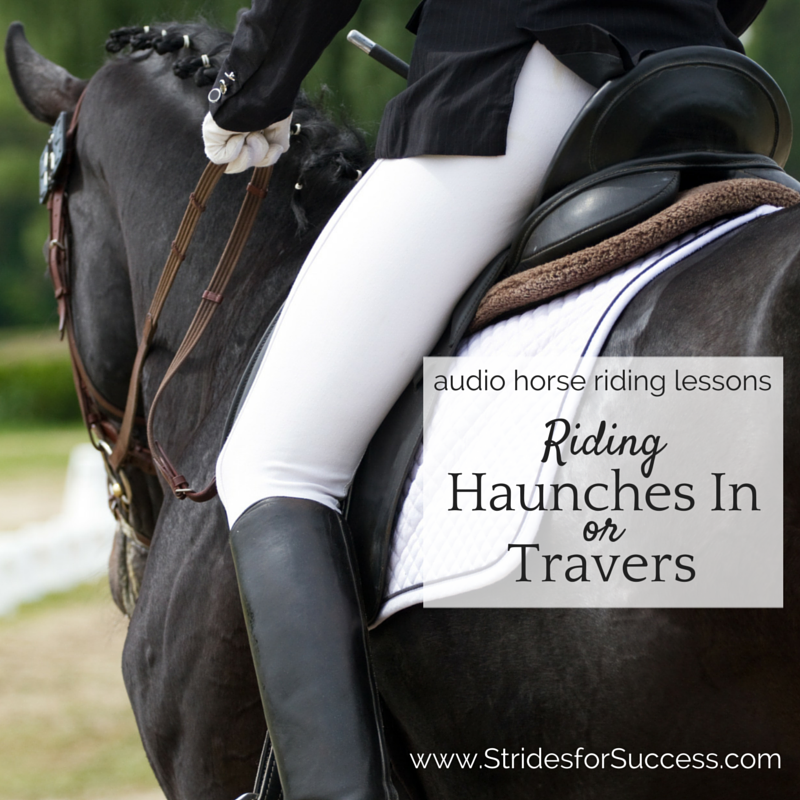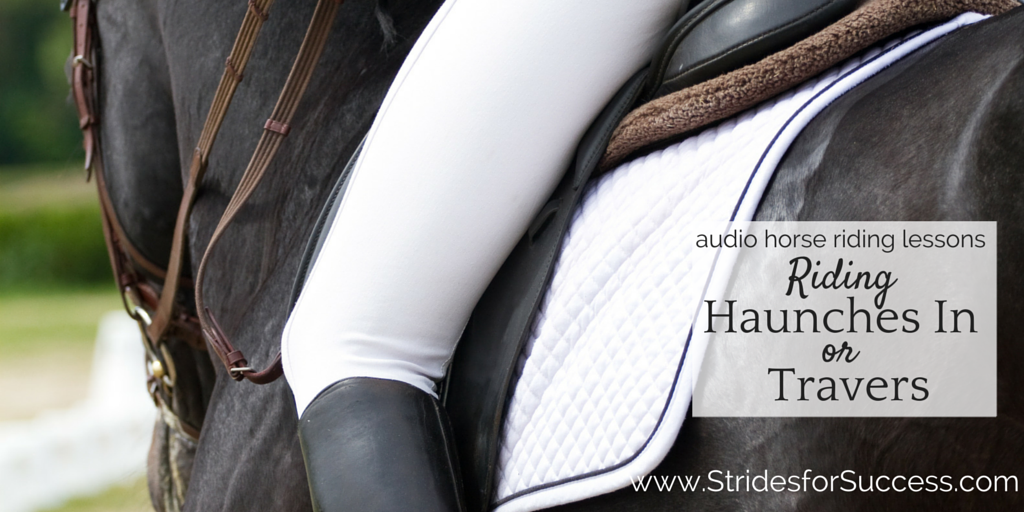Do you find that when you ask your horse to perform haunches in or travers, the forward movement tends to get a little ‘stuck’? It feels as though he is on his tippy toes, pottering along with no inclination to get to the other end of the arena?!
The Benefits of Haunches In
Haunches in is a lateral movement that is fantastic for suppling your horse and it also opens the door to performing a half pass later in training.
It requires an engagement of the hindquarters, due to the outside hind leg having to move over and almost in front of the inside hind leg, and so incorporating this movement into your schooling will, in turn, help strengthen your horses’ hindquarters.

I find that haunches in is also a great exercise to improve the rider’s coordination, both physically and in their head. It also helps to take the confusion out of riding lateral movements on their horses.
What is Travers (or Haunches In)?
You ride this movement by asking your horse to move his hindquarters or haunches in off the track. So, towards the inside of the arena if you are on the outside track. As he continues to move forward, his shoulders remain on the track.
He does this by bending around your inside leg at an approximately 30-degree angle to the track.
How Much Bend Off the Track?
If you looked at your horse moving down the arena, from the front, you would see either 3 or 4 distinct tracks created by your horse’s hooves. I say 3 or 4 because this depends on what level in his training your horse is at. It can also depend on how he is put together.
A simple way of imagining how haunches in should look when being ridden is to think the ‘last stride’ of a circle or bend, just before your horse straightens up again.
Now imagine holding this position as you ride down the long side of the arena. Your horse’s shoulders would be on the track. However, the hindquarters or haunches would be slightly in off the track as he bends around your inside leg.
Getting Started…
Haunches in or travers can be performed in walk, trot or canter and, as always, I suggest first asking for the movement in walk before building up to faster gaits. This will give both you and your horse the opportunity to figure out what to do when it is being ridden.
Start in a walk on a 10-meter circle in the corner before the long side of your arena. Focus on establishing and maintaining a correct bend while on the circle. Do this by applying the half halt as necessary to re-balance your horse, and let him know something is happening.
Your Aids for Haunches In
As you come out of the corner on the circle, use your outside leg to keep your horse’s hindquarters off the track. They will be closer to the inside of the school. Do this by bringing it back and maintaining the bend around your inside leg.
Make sure the shoulders remain on the track by using your inside leg on the girth.
Your inside leg will also help create the bend and continue to create the forward energy that is essential to prevent you and your horse from becoming ‘sticky’ while riding the haunches in.
Work towards maintaining the bend around your inside leg and ask your horse to move down the long side with his hindquarters to the inside and off the track. Continue to half halt throughout the movement to re-balance. Also, pay attention that your horse is not over-bent,
Only ask for a few strides of travers initially, working up to longer periods as your horse becomes stronger and grows his confidence in his ability.
The Balance of Aids…
Make sure your inside leg is continuing to create forward impulsion as you perform the movement. Also, continue to check that you are not applying too much inside rein. This will result in you ‘pulling’ his head and neck around.
Over-bending through the front end will prevent your horse from stepping out correctly. This will ultimately lead to the short, choppy, sticky steps that we often achieve when riding haunches in.
Don’t worry too much about the angle initially. Rather focus that your horse is listening to your aids and responding. Even if that response is not as ‘active’ or expressive as you would like it to be. As he becomes more supple, you can ask more difficult questions of him and work on ‘polishing’ the movement up.
Alignment Through Your Position
All the while, both before, during, and afterward, make sure your body and position are correct. Also, that you are applying and using your aids as clearly for your horse to understand as possible.
Often when we are not getting the desired result, riders can ‘fight’ with their horse; pulling, pushing, and shoving in frustration. Rather realize that if what you are doing is not working, go back a step or two, perhaps to leg yielding, and after re-establishing a solid foundation, ask again.
Try not twist or slouch your body while riding. It is tempting to ‘look’ your horses hind quarters to see if you are achieving what you are setting out to do; rather use your seat to ‘feel’ what is going in and ‘glance’ with your eyes that the shoulders are remaining on the track.
Also, think about your seat aids as you prepare and ride the haunches in movement. Don’t try to influence your horse to ‘go sideways’ by swinging your seat around in the saddle. Simply make sure your inside seat-bone is slightly more forward than your outside. A little like when you are asking for a bend. Also, pay attention that you are not collapsing through the inside hip and shifting all the weight onto your outside seat-bone.
Developing the Movement
Once you and your horse have successfully performed the movement in the walk, you can begin to add trot. You can also later add canter into your schooling time.
Pay attention that your horse is truly bending around your inside leg, otherwise he may just be leg yielding!
Another exercise you can ride is a 20-meter circle, which using haunches in, you can spiral smaller into a 15 meter or even 10 meters if your horse is balanced enough.
From there you can use shoulder in to move your horse back out to the original 20-meter circle.
This can be ridden on both reins in all three gaits and is a simple way of incorporating this movement into your daily schooling routines.
Happy Riding
Lorna
Additional Resources for Equestrians
-
-
- Following & Allowing in Your Riding
- Turn on the Forehand
- Lateral Movement; Leg Yielding
- Simplifying Shoulder In
- Online community for equestrians working on their mindset & fitness
- Online Community for equestrians focusing on re-schooling horses (and ex-racehorses)
- The Daily Strides Podcast on iTunes
- Daily Strides Podcast on Google Play
- The Daily Strides Podcast on Stitcher Radio
- Join Connection
-

